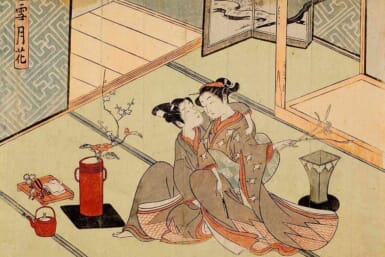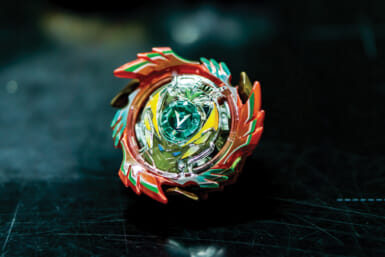by Yurie Horiguchi
The other day I gave a talk to the Mothers’ Club of the Sacred Heart International School on the subject of Japanese women.
Because of certain feedback I have since received. I would again like to stress that it is impossible to generalize about women. They are as unpredictable as the weather, and no two are exactly alike. Some may be docile and meek all the way through, without the will of steel that others possess, and vice versa.
The picture I tried to give was an overall study of woman’s place in society and her condition over the past 1,000 years, objectively, not subjectively.
When speaking of woman’s role as the household controller of finances, I was referring to the vast majority who make up the middle and lower classes in Japan.
Of course the situation is different in wealthy households, and among those ladies who are members of Tokyo’s foreign society.
Incidentally, since I have mentioned the weather—did you know that Japan is surely the only country that gives forecasts in terms of probability?
They never come out straightforwardly with “Today will be fine.” They always say “Today will be fine, perhaps.” (Kyo wa hare desho). That word desho, meaning probably, or perhaps, is added to the end of every weather forecast and is a great escape clause.
I would also like to expand on the subject of arranged marriages as there seems to be some misconception among foreigners on the matter, especially among Americans.
First, arranged marriages are not an invention of the Japanese. They have been, and still are, practiced in Europe, particularly among the aristocracy and the haute bourgeoisie of countries such as France, Italy, Spain and Portugal. And in China, too.
Kings and Queens in olden days often never met their bride or groom until the day of the wedding, and many even were married by proxy before setting out for their new land.
In Japan, the custom started also within the imperial court circles many centuries ago, spreading down through the ages to encompass common people.
Since Japan has always been – and still is, to a certain extent–a society-conscious nation. It was one means of keeping stability and homogeneity within social ranks.
But as in Europe, many Japanese aristocrats in the past half-century found that only marriage outside their own social rank, that is, marriage with the daughter of a rich commoner of the formerly disdained “merchant class” could enable them to maintain their estates.
In France they call it to “dorer le blason,” or to “gild the family arms.” And inversely, a rich commoner often sought, and found, the daughter of an Impoverished aristocrat of impeccable lineage to “ennoble” his house.
In both cases, the marriages are arranged principally In the interests of the families concerned, without really taking into account the feelings or desires of the young couple. But these marriages are not bad things in themselves as they bring invigorating new blood into families where too much inbreeding has weakened physical qualities. And it is generally a fair bargain for both sides: a title for solvency, and riches and comfort in lieu of gentle poverty.
In today’s Japan, an arranged marriage does not mean that an unwilling maiden or youth is dragged screaming to the altar (or shrine) by parental decree.
When a daughter reaches marriageable age (from 23 on) and has no particular boy-friend in whom she is interested, her family will approach a close relative or friend (who becomes the go-between or nakodo) to ask if he or she (usually she) knows of any personable young bachelor susceptible of becoming interested in their daughter.
And often the family of a young bachelor seeks a wife for him in the same manner.
Armed with a studio portrait of the young girl (or man), the go-between will then visit possible prospects. In some cases, she will also take with her a written “personal history” of the young person.
She talks to the parents and if they approve, they in turn talk to their son or daughter. He/she studies the photograph, and if it is pleasing, will accept a first meeting, or omiai, which can literally be translated as “eye-meeting.”
The parents on both sides, together with the go-between, are present at this omiai, which usually takes place In an hotel or cafe.
Conversation is therefore spread around, and the young couple are not forced to speak to each other if the omiai does not “take.”
On their return home, the daughter or young man will give their opinion to their parents. If there is no mutual attraction, the go-between is informed and the matter is closed.
But the search doesn’t end there. Some young people go through several omiai before they meet the man or girl who pleases them.
They are then given liberty to “date” as often as they wish, to get to know each other better. In many cases, they fall in love during this courting period. In others, they learn to appreciate each other and find that they share common interests.
If passion and purely sexual attraction are absent from some arranged marriages, they are often replaced by mutual respect and friendship which, in time, can develop into an abiding affection.
As for “love marriages,” there is not too much difference these days between the latter and the arranged, except for the fact that the young people find their own mates without the official services of a go-between.
If “love marriages” are on the increase, it is due to the removal of segregation in schoolrooms and universities, and also to the fact flint many young girls seek “pre-marriage” jobs in offices in the hope of meeting a likely victim.
In middle and upper class families, parents are generally consulted by the protagonists before such a marriage takes place, and the young man, or girl, is properly introduced to the family.
If the young couple is very much in love, it makes no difference whether the parents are against the marriage as in the West.
But when it comes to the wedding ceremony proper, if it is a Shinto wedding, back comes the go-between! He or she is merely symbolic, and is often chosen from among the youth groom’s office superiors; and in some cases may never even have met the bride before the ceremony.
The presence of the go-between at the ceremony gives “face.” He and his wife sit at the bridal table, on the outer sides of the bride and groom, and the male go-between makes the first speech. His wife acts as a sort of matron-of-honor to the bride.
So, to all outward appearances, the “love marriage” is an arranged one.
Which holds up better— the arranged or the love marriage? As in all marriages, only time can tell.
The manner in which couples develop their relationship, adjust to each other and practice the necessary give-and-take of married life is the same the world over.
The Japanese—and European — arranged marriage has perhaps a slightly better guarantee of future harmony because it takes into account the social and cultural background of the young couple.
Where there is too much disparity in upbringing and culture, certain difficulties can arise but that is another story.








